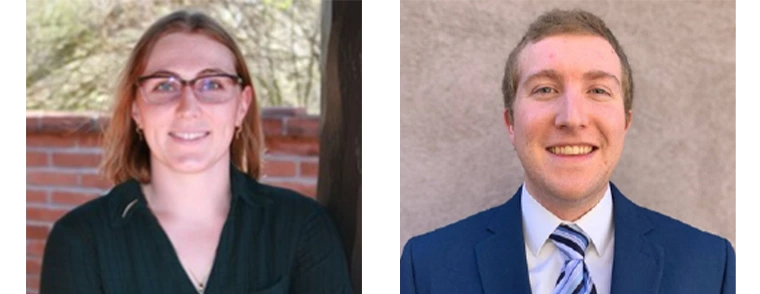When

Monday, October 28, 2024 - 12:00 p.m.
Laurel Dieckhaus and Devin Murphy
PhD Candidates in Biomedical Engineering
University of Arizona
Keating 103
Zoom link | Password: BearDown
Hosts: Dr. Alex McGhee & Dr. Swarna Ganesh
(Instructor permission required for enrolled students to attend via Zoom)
Persons with a disability may request a reasonable accommodation by contacting the Disability Resource Center at 621-3268 (V/TTY).

"Using Bias-Free Multi-dimensional MRI Analysis Method to Resolve Age-related Differences in the Ex-Vivo Female Bonnet Macaque Brain"
Abstract: There are several Magnetic resonance imaging (MRI) quantitative maps that may be sensitive to age-related brain changes, but it is unclear which maps offer the most information. In addition to discerning which singular MRI quantitative map provides the most sensitivity to age-related changes, it is possible that a combination of maps may be more informative. We used a voxel-wise binary classifier to identify aged-related changes across the female bonnet macaque whole brain with multi-parametric MRI datasets, which were composed of different MRI maps. Non-human primates provide an excellent model to determine lifespan-related brain changes with MRI. Additionally, ex- vivo whole brain imaging allows for collection of a variety of MRI map types at high resolution that would otherwise be time constrained in-vivo. Diffusion and relaxometry derived MRI maps were obtained at 200-to-600-micron resolution isotropic in seven female bonnet macaque ex-vivo brain specimens ranging in age from 10-34 years. Diffusion-based maps included Fractional Anisotropy, Axial Diffusivity, Radial Diffusivity, and Trace, which measure diffusion of water and assesses white matter tract geometry. Relaxometry-based maps included T2, R2star, Myelin Water Fraction, and Bound Pool Fraction, which measure the biophysical properties of tissue such as myelin and iron content. These maps were warped to a template space for group analysis. We classified mid-age (14-21 years, n=3) vs. late-age (28-34 years, n=4) brains using three MRI datasets: all metrics, diffusion-only, and relaxometry-only. For each voxel in the brain, the accuracy of predicting late- versus mid- age was calculated. We present our current findings here and discuss the potential use of this bias-free multi-dimensional MRI approach to measure multiple biological processes relevant to aging and their potential application to larger datasets.
"Multi-Modality Imaging and Analysis of Mouse Cortex after Focused Ultrasound-Induced Blood-Brain Barrier Opening"
Abstract: Focused ultrasound (FUS) has been introduced as a novel method of transiently opening the blood-brain barrier (BBB) for drug delivery and therapy in neurodegenerative disease1. The gold-standard for confirmation of BBB opening after FUS is T1-weighted MRI with gadolinium-based contrast agent (GBCA)enhancement. While this method provides reliable and accurate localization of BBB opening within thebrain2,3,4,5, MRI does not have the spatial resolution to resolve local distribution or kinetics of solute delivery to the brain tissue6. Currently, it is not established which vessels are opened or the spatiotemporal distribution of solutes relative to the targeted cells. In vivo 2-photon microscopy (2PM) can be used to investigate microvascular changes in the cortex after FUS and can be used in combination with MRI to better understand the effect of FUS on tissue microvasculature and parenchymal kinematics. Results from such multimodality experiments are presented here, where FUS, MRI and 2PM are carried out in the brains of mice to investigate the effects of FUS on microvasculature and the movement of molecules across the blood-brain barrier.
